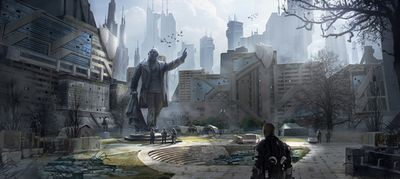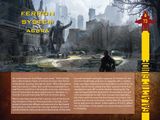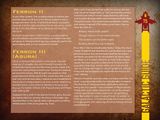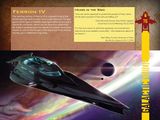As noted historian Ariel Rutte once wrote, “If the Sol System is the Empire’s heart, and Terra its head, then Ferron is the blood coursing through its veins.” When the system was discovered in 2460, few could have predicted how vital Ferron would be in driving the economy and expansion of Humanity’s burgeoning Empire for decades, or how far it would eventually fall from its former glory.
Ferron was discovered by Pali Laumet, one of the founding members of the Sol Astroexploration Society. Composed of extremely affluent adventurers who dedicated themselves to the search for new star systems, the S.A.S. can be linked to many jump point discoveries of the time. Laumet had been sailing the expanse of Croshaw for several months already, and, low on supplies with a restless crew, was days away from having to return to Sol when his stoker, Darcy Ferron, noted that their quantum drive fuel calculations were off. Laumet, double-checking the figures, surmised that the extra burn-off was due to the pull of an unmarked jump-well. Sure enough, two days later, the crew would become the first Humans to jump to the system that Laumet graciously named after the perceptive Darcy, and upon his return, in the tradition of S.A.S, gifted the coordinates of the system as a philanthropic donation to Humanity.
After initial government surveys were complete, the system was declared an ideal candidate for settlement and opened to the public. Corporate and private interests sped to the system, eager to stake their claim. The ensuing battle for land and mineral rights grew so unruly that the UNE intervened and established a lottery to help arbitrate the disputes. After the first drawing took place, a myriad of loopholes and flaws were uncovered that had given some parties and companies unfair advantages which took years to be sorted. The government’s failed attempts at mediation served to highlight both the impotence and inefficiencies of the UNE as it struggled to cope with Humanity’s rapid expansion. Some historians theorize that the bureaucratic failings during Ferron’s lottery fanned the flames of reform that eventually lead to the dissolution of the UNE and the formation of the UPE in 2523.
Despite its troubled start, Ferron was already on the fast track to prosperity due to its wealth of natural resources. Before long it was a bustling hub of mining and trade, and, in 2529, the system achieved represented status within the UPE. Centuries of success followed as the system provided the materials necessary for Humanity to conquer the stars. In its heyday, Ferron’s population had grown enough to rival that of Sol and it was well on its way to becoming a political equal as well. But sadly, the system’s success would not last.
The first reverse of fortunes occurred in 2791 when Messer XI falsely accused the system of being home to dissidents. Fearful of the Imperator, numerous wealthy Citizens and Messer loyalists fled the system, taking large amounts of funds and clout with them. When the eventual military strike did come, it was only thanks to the legendary bravery of the members of Squadron 78 and their heroic unwillingness to kill civilians that violence was avoided, but by then the economic and political damage to Ferron had already been done.
The next blow would occur in 2832 when Shubin Interstellar announced profit losses for the first time ever in the system. The mining conglomerate cited the depletion of a major mine as the cause and noted that more site closures were expected to follow. This would prove to be Ferron’s death knell. Years of aggressive mining had taken its toll and the system by this time had been nearly picked clean. As fast as its rise to prominence had been, Ferron’s fall from grace would be even faster. Within a single decade, the population of the system dropped by nearly half and its economic health dropped even lower. Today, it is only a shadow of its former glory, the bones of a vibrant system that bled itself dry of resources for the good of the Empire.
While Ferron is far from an ideal destination for the casual traveler, the system has drawn its fair share of visitors attracted by its historical significance, as well as more adventurous prospectors hoping to find some remnants of valuable ore that may have been overlooked.
Ferron I
This dwarf planet sits closest to Ferron’s main star. Uninhabitable and lacking in resources, only the scientific community gives Ferron I much thought due to unusual and so far unexplained variance in its magnetosphere.
TRAVEL WARNING The lack of drinking water on Asura has led to vicious infighting between encampments around the edge of Tram. For this reason, it is highly recommended that all visitors stay within the center of Tram and avoid traveling to the outskirts of the city without local guidance.
Ferron II
In any other system, this coreless planet would be just another dead world, but in the Ferron System it was a disappointment. Ferron II lacked both easily accessible minerals and the right conditions for terraforming, which thrust it into the shadow of its resource-rich neighbor, Ferron III.
However, tough times in Ferron have caused people to give the planet a second look. Many are hopeful that new advances in mining technology may eventually lead to the planet being able to turn some kind of profit.
Ferron III (Asura)
Once considered the system’s crown jewel, the vast reserves of valuable ores and minerals that were discovered during Asura’s terraforming process made it an economic and political powerhouse. During this extended economic boom, little thought was given to what would become of the world if the mines ever did run dry and only minimal secondary industries were established. Asura was a mining planet to its core, and for nearly four hundred years, every shred of planetary resource was dug up, harvested, refined, and shipped away until there was nothing left.
Depleted into a shell of the planet’s former glory, the people descended into poverty. Nowhere is this better represented than in the rapidly deteriorating and crumbling infrastructure of the once great city, Tram.
With most of Asura’s land set aside for mining, the stunning industrial megalopolis of Tram became the planet’s financial and cultural center. Large factories, refineries and housing developments were interspersed with beautiful public parks. This visual harmony between nature and industry inspired 27th century poet Lelani Toan to describe Tram as — Balance, beauty both created Through industry of man which elevated This random rock that within teems Building blocks for a city of dreams.
Now, life in Tram is considerably harder. Today, the city is mostly shuttered and abandoned, and its skies are a near permanent gray from all the toxins that the have been carelessly pumped into the atmosphere by heavy industry. Water is in constant demand, as most of the natural supply has been equally contaminated. And as for the population that does remain, while some civilians still eke out a living with repair or refueling stations, criminal enterprise has surpassed any legitimate business as the main industry.
Visitors should be cautious when moving around the city as an ongoing police strike has considerably increased the chances of being accosted, particularly when entering the city’s parks — now a hotbed of illegal activity. Those looking for deals should visit one of the planet’s mining superstores where equipment sits gathering dust. Remember to take a trusted friend, co-worker or hired guard along. Criminal elements have been known to target guests who make significant purchases at local establishments.
Ferron IV
The swirling surface of Ferron IV is a beautiful sight that pilots have learned to enjoy from a safe distance. The gas giant’s thick layer of metallic hydrogen behaves as a giant electrical conductor, which can be severely problematic for a ship’s sensitive avionics. Bands of outlaws have been known to lurk on the fringes of the electrical field, waiting to prey upon malfunctioning ships.
Heard in the Wind
"How can we be expected to protect the people of Tram, when it’s the damn people of Tram who are killing us?"
Clair Slovonik, Former Tram Police Captain, Governors Council Meeting, 05.22.2936
"For Ferron to return to its former greatness, we must strive to resurrect its most valuable commodity — the industrious nature of its Citizens.”"
Paul Dibly, Former Governor of Tram, Re-Election Speech, 09.17.2912






